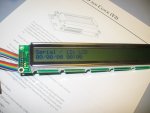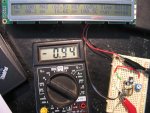I've been experimenting with some LCDs for picaxe from www.shopeio.com
I have some 16x1 displays and some 40x2 displays.
Both appear to work ok with both the axe033 driver kit and the Peter Anderson driver kit, except that the contrast makes the displays virtually unreadable.
I have a couple of 'standard' LCDs as well that work as expected with both drivers. One came with the axe033 kit, the other with the Anderson kit. Both of these are 16x2.
At first I thought it was just that the driving voltage was too low (ie. 4.5 volts rather than 5 volts). I have run both a 'standard' LCD and the 40x2 off the same 5 volt supply and driver. While the standard unit is clear, the 40x2 is not at all. I actually have two 40x2 LCDs and the result is the same with both of them.
The device is a seiko L4042 with LED backlight. I have done a lot of looking around for contrast solutions to this LCD without success. The Anderson board has a fixed voltage on the contrast line, while the Rev-Ed kit has a pot to adjust. Does anyone have experience with this or ideas about how to fix the problem.
Any help would be appreciated.
I have some 16x1 displays and some 40x2 displays.
Both appear to work ok with both the axe033 driver kit and the Peter Anderson driver kit, except that the contrast makes the displays virtually unreadable.
I have a couple of 'standard' LCDs as well that work as expected with both drivers. One came with the axe033 kit, the other with the Anderson kit. Both of these are 16x2.
At first I thought it was just that the driving voltage was too low (ie. 4.5 volts rather than 5 volts). I have run both a 'standard' LCD and the 40x2 off the same 5 volt supply and driver. While the standard unit is clear, the 40x2 is not at all. I actually have two 40x2 LCDs and the result is the same with both of them.
The device is a seiko L4042 with LED backlight. I have done a lot of looking around for contrast solutions to this LCD without success. The Anderson board has a fixed voltage on the contrast line, while the Rev-Ed kit has a pot to adjust. Does anyone have experience with this or ideas about how to fix the problem.
Any help would be appreciated.




